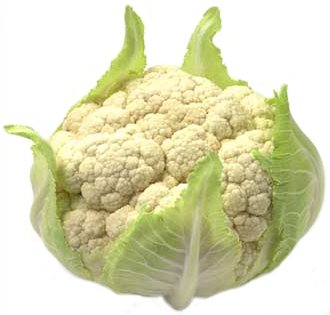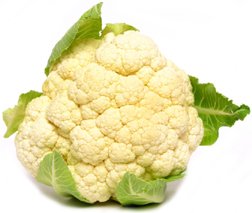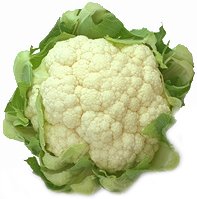

Cauliflower

Cauliflower, broccoli. Brassica oleracea, Cotyris Group. Cruciferae. A close relative of the cabbage, grown for its edible inflorescence. This is made up of thick, fleshy flower stalks which form a compact, almost spherical ‘curd’ which is usually white. Most cultivars are annuals and produce a curd in the year of sowing but there are a number of biennials and intermediate types which require exposure to a period of low temperature before initiating curds. The species probably originated in the Mediterranean area but the cauliflower does not appear to have been cultivated widely until the 18th century. It is now grown throughout the temperate regions and is a major commercial crop in France, Italy and Britain. High temperatures make its cultivation difficult in tropical areas but some cultivars may be grown during the cool season and at high altitudes. The curds may be split into segments and cooked by boiling or used in pickles. They are also suitable for freezing. The main factor controlling the growth and development of cauliflower is temperature. In temperate zones, annual types develop a certain number of leaves, a prerequisite to curd formation. The optimum temperature for this transition is around 17ºC and at temperatures above 20ºC resultant curds may be of poor quality or may not be produced at all. Thus in hot climates many cultivars will produce leaves only. Biennial and intermediate types require exposure to temperatures below 10ºC before curd initiation occurs and transition will not generally be possible until plants have reached specific size which, again, is cultivar- dependent. This, together with differences in total cold requirement, enables growers to select cultivars for harvesting throughout much of the year. In situations where temperatures are fluctuating around the threshold for curd initiation the plant may switch back to vegetative growth, resulting in bracts appearing in the normally uniform curd. Winter cauliflowers are hardy before curd formation and can withstand temperatures of –6ºC without serious damage. The curd, however, is more sensitive and will be damaged by temperatures below –2ºC. In frost-free locations harvesting may continue from late summer through to the following spring and, by raising seedlings under protection for early planting, it is possible to carry out year-round production in favourable areas. Cauliflowers need to produce strongly early vegetative growth and require a sunny site and a fertile, loamy soil with a pH of 6.0-7.0. Well-rotted organic matter should be incorporated into lighter soils. Liming should be carried out on acid soils to raise the pH and reduce the danger of club root infection. The crop is established from transplants from seed either sown in outside seedbeds or, in the case of early summer crops, in modular trays, peat blocks or pots, under glass during the winter. 
Seeds should be sown thinnly in 1cm deep drills 20-30cm apart and later thinned to prevent overcrowding. Glasshouse-raised transplants should be hardened off prior to planting in their final position. The young plants should be watered in well at transplanting. Spacing will depend on cultivar but the early maturing summer ones will require about 45 x 45cm and the overwintering crop will need a wider spacing of around 60 x 60cm or more. Manipulation of plant population is a useful way of regulating final plant size and by planting at high density it is possible to produce mini-cauliflowers with curds measuring between 4-9cm in diameter. These will occupy the ground for a shorter time than the traditional crop and may be cooked or frozen whole. This technique is more suitable for the early summer cultivars and the crop should not be transplanted but established from a direct sowing later thinned to give a final spacing of about 15 x15cm. For high-quality curd production, plants must maintain strong growth and should be kept well watered and if necessary given a top dressing of nitrogen fertiliser. Harvesting should take place when curds are still firm, since if left too late they will become loose and discoloured. Additional protection of the developing curd can be given by bending a larger inner leaf over it. Cultivars of cauliflower are grouped according to their period of maturity. Those for harvesting in early summer are quick growing and produce small plants with firm white curds. They include ‘Delta’, ‘Snowball’ and ‘Alfa’ types, also ‘Montano’, with knobbly curds, ‘Self Blanche’, ‘Snow Crown’ and ‘Snow King’, pure white. ‘Nine Star Perennial’ produces small, white heads in spring and early summer for up to 4-5 years. Slightly later cultivars in the summer or autumn group include a number of cultivars of French, Italian and Australian origin such as ‘Flora Blanca’ types and ‘Le Cerf’. The winter cauliflower and the winter cauliflower for spring heading (sometimes referred to as ‘broccoli’) include the ‘Roscoff’ types and ‘English Winter’ types. Cultivars include ‘Autumn Giant – Veitch’s Self-Protecting’, ‘Barrier Reef’ and ‘Canberra’, all white; ‘Romanesco’, with green head forming a series of small pinnacles. Although the traditional cauliflower cultivars are generally white-curded there has been increased interest in recent years in the coloured-headed types such as the green-curded ‘Di Macerata’ and ‘Romanesco’. Many of these are of Italian and Portuguese origin and breeding in progress will hopefully both extend the cropping season and provide some tolerance to autumn frosts.
|
Home
Grow Nuts
Grow Herbs
Grow Fruit
Cyberian Index
If you like this website and want one of your own contact
Cyberian All information correct at
time of publication and open to updates as necessary. No part of this website,
or its vectors, may be produced in any shape or form, using any type or design
of medium, system, equipment or otherwise without the prior written consensual
notice of the Cyberian. Any breach of these requirements will result in the
appropriate action. If in doubt, e-mail contact is recommended.
Some components of this website were obtained as open-source software and are
used in the same non-profit manner on this website.